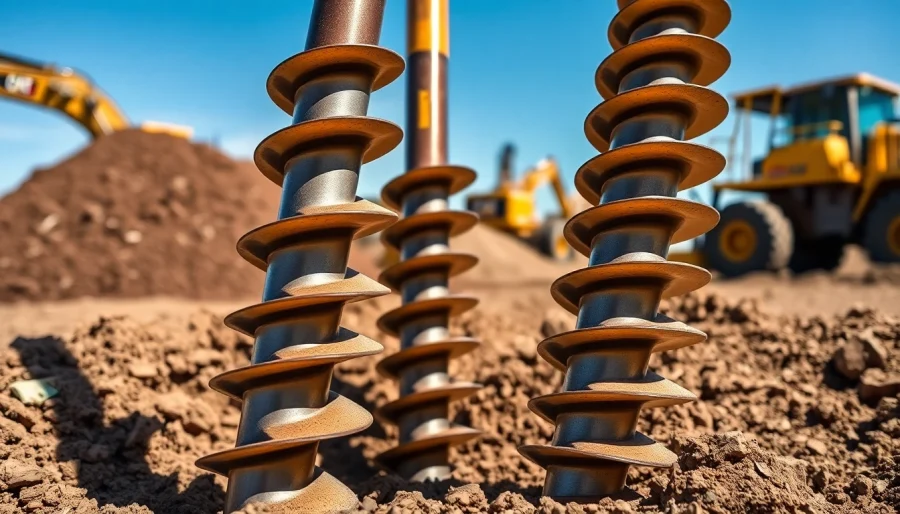Understanding Augers: The Essential Tool for Excavation
When it comes to excavation and drilling, few tools are as reliable and efficient as Augers. These powerful machines are engineered to penetrate various types of soil and materials, making them indispensable in construction and landscaping projects. In this comprehensive guide, we’ll explore what augers are, their different types, their applications in construction, and how to choose and maintain them effectively.
What Are Augers and Their Functionality
Augers are helical devices used to drill holes in the ground. They operate by transferring the rotational force applied by a drive mechanism to a screw-like blade, enabling them to penetrate and remove material efficiently. The basic design of an auger involves a rotating shaft and a series of spiraled blades that lift material up and out of the hole being drilled.
Types of Augers: Which One to Choose
There are several types of augers, each designed for specific functions. Below are the most common types:
- Earth Augers: Commonly used for drilling into soil, these are equipped with sturdy blades ideal for creating holes for fence posts, signs, and planting trees.
- Ice Augers: Designed specifically for ice fishing, these augers allow users to cut through thick ice while maintaining precision and control.
- Post Hole Augers: Specifically designed for digging deep holes for posts, with longer shafts and powerful drilling capabilities.
- Screw Augers: Featuring a continuous screw mechanism, these are often used in mining and industrial applications to move bulk materials.
Common Applications of Augers in Construction
Augers are utilized in various construction scenarios, including:
- Creating foundations for structures by digging post holes.
- Drilling holes for underground utilities and pipelines.
- Planting trees and landscaping by preparing holes in the ground.
- Performing geological assessments by extracting samples from different depths.
Benefits of Using Augers in Your Project
Enhanced Efficiency in Material Removal
Augers streamline the drilling process, allowing for swift penetration and material removal compared to traditional tools like shovels and picks. This efficiency translates into reduced project timelines and increased profitability, particularly for contractors working on tight schedules.
Reduced Labor Costs with Augers
With their ability to quickly and effectively bore through soil and other materials, augers significantly reduce the amount of manual labor required. This, in turn, minimizes labor costs, allowing contractors and project managers to allocate resources to other critical areas of the project.
Comparing Augers with Traditional Digging Methods
While traditional digging methods may seem reliable, they often require more time and physical effort, which can lead to fatigue and decreased productivity. Augers offer the advantage of mechanized digging, ensuring consistent results with less physical strain on workers.
Choosing the Right Auger for Your Needs
Factors to Consider When Selecting Augers
When it comes to selecting the appropriate auger for your project, several factors come into play:
- Soil Type: Consider the density and composition of the soil you’ll be drilling into. Different augers are designed for varying soil conditions.
- Diameter of the Hole: Augers come in various sizes; selecting the right diameter is crucial for your specific needs.
- Depth of the Hole: Ensure that the auger you choose is capable of drilling to the required depth.
- Power Source: Augers can be gas-powered, electric, or manual. Choose based on availability and project requirements.
Top Brands and Models of Augers Reviewed
Several brands are known for producing high-quality augers. Some of the top contenders include:
- Earthquake: Known for their robust construction and efficient performance.
- Milwaukee: Offers electric options appreciated for their reliable power and versatility.
- Husqvarna: Renowned for their professional-grade augers suitable for heavy-duty applications.
How Auger Specifications Impact Performance
The specifications of an auger, including blade design, motor power, and shaft length, directly influence its efficiency and effectiveness. For instance, augers with wider blades can remove more material at once but may require more power. Conversely, a narrower blade might be ideal for precise digging in tight spaces.
Best Practices for Operating Augers Safely
Essential Safety Gear for Auger Operators
Safety should always be the primary concern when operating any excavation equipment. Essential safety gear includes:
- Hard hats to protect against falling objects.
- Protective eyewear to shield from debris.
- Gloves for grip and safety.
- Sturdy boots with steel toes for foot protection.
Pre-Operation Checklist for Augers
Before each use, operators should perform a thorough checklist, including:
- Inspecting the auger for any visible damage or wear.
- Checking fluid levels and ensuring the power source is operational.
- Ensuring safety mechanisms are functional.
- Confirming all attachments are secure.
Common Mistakes to Avoid When Using Augers
To ensure safe and effective operation, operators should avoid these common mistakes:
- Neglecting proper gear, which can lead to injuries.
- Forgetting to follow the manufacturer’s instructions for operation.
- Overloading the auger, risking damage to the equipment and potential accidents.
Measuring the Performance of Your Augers
Key Metrics to Track During Use
Tracking performance metrics is crucial for maximizing the efficiency of your augers. Key metrics include:
- Rate of penetration—this measures how quickly the auger can drill through material.
- Material removal rate—this indicates how much material is effectively displaced by the auger.
- Fuel or energy consumption to monitor efficiency and adjust as needed.
Maintaining Your Augers for Longevity
Proper maintenance is essential to keep augers functioning optimally. This includes:
- Regular cleaning to remove dirt and debris.
- Inspecting and sharpening blades as needed to maintain efficiency.
- Lubricating moving parts to reduce friction and wear.
Real-World Case Studies: Successful Uses of Augers
Case studies highlighting successful auger applications offer valuable insights. For instance, a landscaping company utilized augers to plant hundreds of trees efficiently, reducing labor costs by 50% while maintaining high precision and minimal soil disturbance. Another case involved a contractor drilling for utilities, where using augers sped up the installation timeline significantly, showcasing the benefits of efficient planning and execution.
